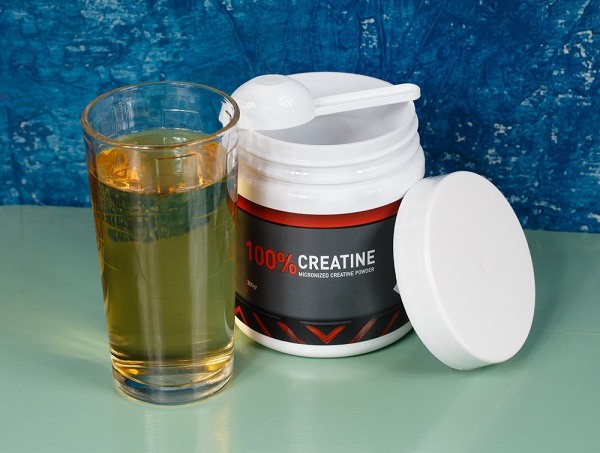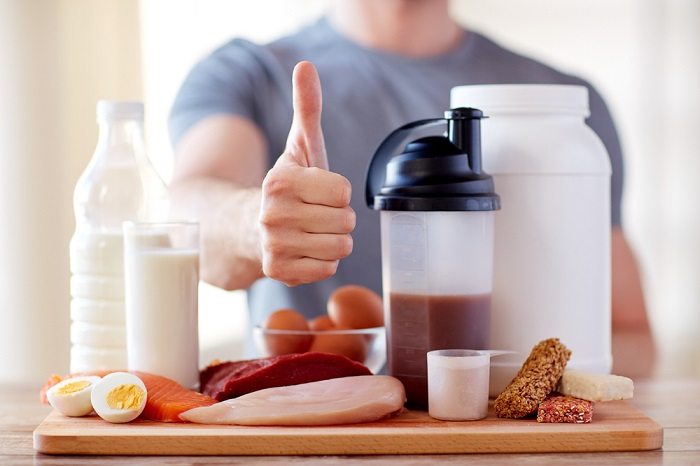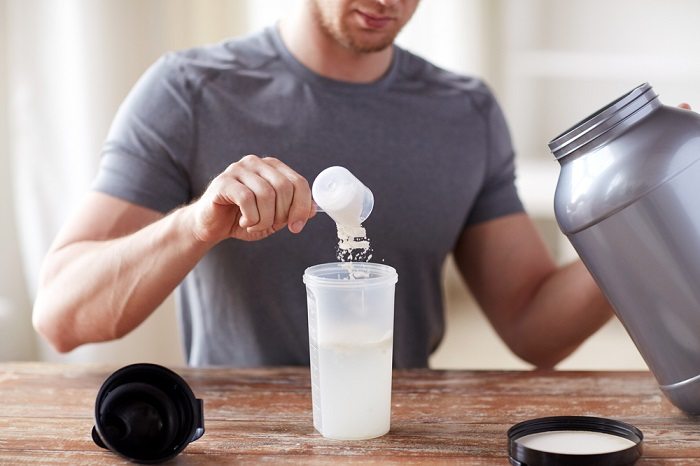If you’re into body building, then I’m sure you must have stumbled upon numerous types of supplements that can help you up your muscle game. One interesting supplement you may have heard of is creatine.
Creatine has easily become one of the most researched supplements in the fitness industry today because of its impressive benefits. If you’re planning to take creatine to boost your workouts but have no idea how to start, read on.
We’ll be sharing all sorts of facts about creatine including the different types available in the market today, the best way to take creatine, as well as its benefits and side effects to the human body.
What Is Creatine
 Before you start taking creatine, it would be best to know what creatine is. Aside from being a known supplement for working out, creatine is an organic product synthesized in the human body. Your liver produces creatine by fusing three different amino acids including methionine, arginine, and glycine. Your body is capable of making a gram of creatine per day. You can also gain creatine from the food you eat, such as beef, pork, and salmon.
Before you start taking creatine, it would be best to know what creatine is. Aside from being a known supplement for working out, creatine is an organic product synthesized in the human body. Your liver produces creatine by fusing three different amino acids including methionine, arginine, and glycine. Your body is capable of making a gram of creatine per day. You can also gain creatine from the food you eat, such as beef, pork, and salmon.
What Does Creatine Do
What creatine does is it helps you gain more energy, therefore making it a great factor for carrying out extra reps and sets in your workout sessions. But since your body doesn’t produce enough creatine to help you gain enhanced performance when working out, supplements in the form of pills, powders, and serums have been created for increased strength and greater gains.
Types Of Creatine
 There are plenty of creatine types available in the market today. Each can be taken differently and can affect your body in a distinct way.
There are plenty of creatine types available in the market today. Each can be taken differently and can affect your body in a distinct way.
Here are some types of creatine that you should familiarize yourself with:
#1 – Creatine Monohydrate
This creatine type is the most commonly used today. The United States alone generates an estimated annual sales of 400 million USD of creatine monohydrate. To use this product, you mix it with water. Each gram can provide 4.40 grams of active product in your body.
#2 – Micronized Creatine
This type of creatine is similar to creatine monohydrate. But micronized creatine has smaller molecules. As an effect of dividing the creatine molecules into smaller bits, your body will be able to absorb them easier.
The benefits of using this type of creatine are that it gives less stomach discomfort and can reduce the bloated feeling you get from creatine’s water retaining functions.
#3 – Effervescent Creatine
This creatine probably is the best-tasting one because of its sugar and sodium. However, even though it has a great taste, it may not be the best choice for you if you’re trying to lose weight.
#4 – Creatine Serum
Liquid forms of creatine have been quite a controversy since it hasn’t been proven to have any results at all. This type of creatine gets dissolved in water along with several types of amino acids and vitamins.
#5 – Creatine Phosphate
This creatine comes with a heftier price tag than the most commonly used ones. However, even though you would expect it to have greater benefits because of the price, this type of creatine produces approximately 20% less creatine per molecule as opposed to creatine monohydrate.
#6 – Creatine Citrate
If you are easily susceptible to stomach discomfort, creatine citrate might be the best choice for you. This type of creatine is fused with molecules that help increase absorption, giving you less stomach discomfort after intake. However, it comes with a hefty price and only 400 milligrams of active creatine per gram.
#7 – Kre Alkalyn
If you are keen on building muscles and would like quick bursts of energy, this type of creatine is your best bet. Kre Alkalyn is processed under higher PH levels than regular creatine, making it one of the types to have the fastest absorption rate.
As an effect of quick absorption, you will no longer need a loading phase when starting to take creatine. You also won’t experience the bloated look that you get from taking other types of creatine.
#8 – Creatine Ethyl Ester
This creatine is probably the easiest to absorb since it’s deemed to be ten times more soluble than regular creatine. Creatine Ethyl Ester is made up of a byproduct of alcohol and acid, making for better absorption.
Because of its readily absorbable properties, this type of creatine completely rids you of that bloated feeling and requires you to take smaller doses.
Benefits And Side-Effects Of Creatine
 When taken in proper doses and with precaution, creatine can significantly help with your workout sessions. Some of the most sought-after benefits of creatine are increased muscle strength and size, improved muscle recovery, enhanced sprint performance, and more power and energy to execute several reps and sets. Creatine has even been proven to increase brain function.
When taken in proper doses and with precaution, creatine can significantly help with your workout sessions. Some of the most sought-after benefits of creatine are increased muscle strength and size, improved muscle recovery, enhanced sprint performance, and more power and energy to execute several reps and sets. Creatine has even been proven to increase brain function.
However, if taken in extremely high doses, creatine becomes a threat to your body. It can lead to stomach pain, diarrhea, muscle cramps, dehydration, and nausea. It can also result in more serious issues with your heart, kidney, and liver.
How Much Creatine Should You Take
The amount of creatine you should take will depend on your body weight. To avoid overdosing in creatine, you may refer to this guide.
| BODY WEIGHT | GRAMS PER DAY |
|---|---|
| Below 155 lbs | 4-8 grams |
| 156 to 175 lbs | 5-9 grams |
| 176 to 199 lbs | 6-10 grams |
| 200 to 225 lbs | 7-11 grams |
| Above 225 lbs | 8-12 grams |
Ways To Take Creatine
 There are several ways you can start taking creatine. Each one has been made to fit individual lifestyles. But one of the most suggested ways to start is the first one on this list. However, even though the following ways are completely safe, we suggest that you check with your physician or professional trainer to avoid serious health issues.
There are several ways you can start taking creatine. Each one has been made to fit individual lifestyles. But one of the most suggested ways to start is the first one on this list. However, even though the following ways are completely safe, we suggest that you check with your physician or professional trainer to avoid serious health issues.
1. Loading
Loading has easily become the go-to way to take creatine especially if you haven’t taken creatine before. Loading is essentially the act of upping your dosage before you settle into smaller doses for the long run.
To start loading with creatine, you should start taking in doses of 20 up to 25 grams every 5 to 6 days. So that means you should take at least 5 grams of creatine per day. It would also be wise to spread out your doses throughout the day to avoid getting stomach discomfort.
2. Routine
Create a routine for taking creatine to help your body adjust. You can take your creatine anytime you want, since the time has no effect whatsoever on your body. But you must create a routine where you take your doses at the same time every day. This will give your body enough time to process the dose before your the next dose.
If you want to maximize the effect of creatine, do not take it right before your workout like a lot of people do. Instead, have it a couple of hours prior to workouts to give your body some time to absorb the creatine molecules completely.
3. Based On Body Weight
The best way to take creatine is to base it on your body weight. As I have mentioned earlier, doses can be weight-specific. To start taking creatine based on your body mass, you should first calculate your dosage for the first week.
For each kilogram of your weight, .35 grams of creatine is required. So if you weigh 155 pounds or 70 kilos, you would have to take 27.3 grams of creatine on your first week or 3.9 grams per day.
On the following weeks, you should continue to calculate your doses but with a different formula. Instead of .35 grams per kilogram of your weight, calculate your doses based on .15 grams of creatine per kilogram of your weight. So if you weigh 70 kilos, you should take only 10 grams of creatine per week or around 2 grams per day.
A Quick Recap
Creatine is a great supplement to take for your muscle development. It comes in different shapes and sizes including pills, powders, and liquids, and can be easily bought at your local fitness stores. If you’re new to taking creatine, remember to be strict with your doses because taking in high amounts can lead to vital organ issues.
Finally, If you are in the cutting process and wonder whether using creatine is good or bad, take a look at this guide from Topstretch.com.
Have you tried any of the creatine types we mentioned above? How’s it working for you? Let’s leave our feedback in the comments below! If you found this article helpful, please don’t forget to share it too!

Hi there,
I’m Gregory Brown, chief editor at ConstructMuscles.com
I spend half of my time in this blog while the other half on being physical fitness trainer. Believing in the great benefits of bodybuilding and fitness to the body, I’ve been motivated to become a fitness enthusiast. It also was what gave me the self-confidence and assurance within myself both physically and psychologically.


You must be logged in to post a comment.